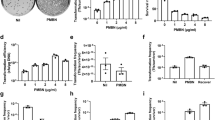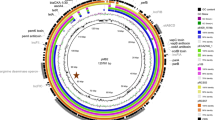Abstract
A determinant encoding resistance against potassium tellurite (Ter) was discovered in a clinical isolate ofEscherichia coli strain KL53. The strain formed typical black colonies on solid LB medium with tellurite. The determinant was located on a large conjugative plasmid designated pTE53. Electron-dense particles were observed in cells harboring pTE53 by electron microscopy. X-Ray identification analysis identified these deposits as elemental tellurium and X-ray diffraction analysis showed patterns typical of crystalline structures. Comparison with JCPDS 4-0554 (Joint Committee on Powder Diffraction Standards) reference data confirmed that these crystals were pure tellurium crystals. In common with other characterized Ter determinants, accumulation studies with radioactively labeled tellurite showed that reduced uptake of tellurite did not contribute to the resistance mechanism. Tellurite accumulation rates forE. coli strain AB1157 harboring pTE53 were twice higher than for the plasmid-free host strain. In addition, no efflux mechanism was detected. The potassium tellurite resistance determinant of plasmid pTE53 was cloned using bothin vitro andin vivo techniques in low-copy-number vectors pACYC184 and mini-Mu derivative pPR46. Cloning of the functional Ter determinant into high-copy cloning vectors pTZ19R and mini-Mu derivatives pBEf and pJT2 was not successful. Duringin vivo cloning experiments, clones with unusual “white colony” phenotypes were found on solid LB with tellurite. All these clones were Mucts62 lysogens. Their tellurite resistance levels were in the same order as the wild type strains. Clones with the “white” phenotype had a 3.6 times lower content of tellurium than the tellurite-reducing strain. Transformation of a “white” mutant with a recombinant pACYC184 based Ter plasmid did not change the phenotype. However, when one clone was cured from Mucts62 the “white” phenotype reverted to the wild-type “black” phenotype. It was suggested that the “white” phenotype was the result of an insertional inactivation of an unknown chromosomal gene by Mucts62, which reduced the tellurite uptake.
Similar content being viewed by others
References
Bradley D.E., Grewal K.K., Taylor D.E., Whelan J.: Characteristics of RP4 tellurite-resistance transposon Tn521.J. Gen. Microbiol. 134, 2009–2018 (1988).
Burian J., Beňo J., Mačor M., Guller L., Siekel P.: Inducible resistance to tellurite in a human isolate ofE. coli.Biológia 45, 1021–1026 (1990).
Clewell D.B., Helinski D.R.: Supercoiled circular DNA-protein complex inE. coli: purification and induced conversion to an open circular DNA form.Proc. Nat. Acad. Sci. USA 62, 1159–1163 (1969).
Fleming A.: On the specific antibacterial properties of penicillin and potassium tellurite.J. Pathol. Bacteriol. 35, 831–842 (1932).
Fleming A., Young M.Y.: The inhibitory action of potassium tellurite on coliform bacteria.J. Pathol. Bacteriol. 51, 29–35 (1940).
Groisman E., Casadaban M.J.: Mini-Mu bacteriophage with plasmid replicons forin vivo cloning andlac gene fusing.J. Bacteriol. 168, 357–364 (1986).
Jobling M.G., Ritchie D.A.: Genetic and physical analysis of plasmid genes expressing inducible resistance of tellurite inEscherichia coli.Mol. Gen. Genet. 208, 288–293 (1987).
Jobling M.G., Ritchie D.A.: The nucleotide sequence of plasmid determinant for resistance to tellurium anions.Gene 66, 245–258 (1988).
Laczaová A., Pechan T., Stuchlík S., Kormuťáková R., Turňa J.: Cloning ofE. coli penicillin acylase gene with mini-Mu containing a plasmid replicon.Biotechnol. Lett. 17, 13–18 (1995).
Lloyd-Jones G., Ritchie D.A., Strike P.: Biochemical and biophysical analysis of plasmid pMJ600-encoded tellurite [TeO3 2−] resistance.FEMS Microbiol. Lett. 81, 19–24 (1991).
Lloyd-Jones G., Osborn A.M., Ritchie D.A., Strike P., Hobman J.L., Brown N.L., Rouch D.A.: Accumulation and intracellular fate of tellurite in tellurite-resistantEscherichia coli: A model for the mechanism of resistance.FEMS Microbiol. Lett. 118, 113–120 (1994).
Maniatis T. Fritsch E.E., Sambrook J.:Molecular Cloning—a Laboratory Manual. Cold Spring Harbor Laboratory, Cold Spring Harbor (New York) 1982.
Osuský M., Stuchlík S., Zamocký M., Dubaová M., Janitorová V., Turňa J.: Vectors with the fd replicon forin vivo cloning and analysis of genes.Gene 151, 103–108 (1994).
Ratet P., Schell J., De Bruun F.J.: Mini-Mulac transposons with broad-host-range origins of conjugal transfer and replication designed for gene regulation studies inRhizobiaceae.Gene 63, 41–52 (1988).
Stuchlí S., Janitorová V., Turňa J.: Cloning of toxic genes with mini-Mu derivative of bacteriophage Mu.Acta Virol. 37, 369–376 (1993).
Summers A.O., Jacoby G.A.: Plasmid-determined resistance to tellurium compounds.J. Bacteriol. 129, 276–281 (1977).
Taylor D.E., Walter E.G., Sherburne R., Bazett-Jones D.P.: Structure and location of tellurium deposited inEscherichia coli cells harbouring tellurite resistance plasmids.J. Ultrastruct. Mol. Struct. Res. 99, 18–26 (1988).
Taylor D.E., Hou Y., Turner R.J., Weiner J.H.: Location of a potassium tellurite resistance operon (tehA tehB) within the terminus ofEscherichia coli K-12.J. Bacteriol. 176, 2740–2742 (1994).
Tomás J.M., Kay W.W.: Tellurite susceptibility and non-lasmid-mediated resistance inEscherichia coli.Antimicrob. Agents Chemother. 30, 127–131 (1986).
Tucker F.L., Walper J.F., Appleman M.D., Donohue J.: Complete reduction of tellurite to pure tellurium metal by microorganisms.J. Bacteriol. 83, 1313–1314 (1962).
Turner R.J., Weiner J.H., Taylor D.E.: Neither reduced uptake nor increased efflux is encoded by tellurite resistance determinants expressed inEscherichia coli.Can. J. Microbiol. 41, 92–98 (1995).
Walter E.G., Taylor D.E.: Comparison of tellurite resistance determinants from the IncPa plasmid RP4Ter and the IncHII plasmid pHH1508a.J. Bacteriol. 171, 2160–2165 (1989).
Walter E.G., Taylor D.E.: Plasmid-mediated resistance to tellurite: expresed and cryptic.Plasmid 27, 52–64 (1992).
Walter E.G., Thomas C.M., Ibbotson J.P., Taylor D.E.: Transcriptional analysis, translational analysis, and sequence of thekilA—tellurite resistance region of plasmid RK2Ter.J. Bacteriol. 173, 1111–1119 (1991).
Walter G., Weiner J.H., Taylor D.E.: Nucleotide sequence and overexpression of the tellurite-resistance determinant from the IncHII plasmid pHH1508a.Gene 101, 1–7 (1990).
Author information
Authors and Affiliations
Corresponding author
Rights and permissions
About this article
Cite this article
Burian, J., Tu, N., Kl'učár, L. et al. In vivo andin vitro cloning and phenotype characterization of tellurite resistance determinant conferred by plasmid pTE53 of a clinical isolate ofEscherichia coli . Folia Microbiol 43, 589–599 (1998). https://doi.org/10.1007/BF02816374
Received:
Revised:
Issue Date:
DOI: https://doi.org/10.1007/BF02816374




